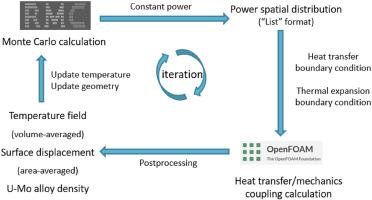Progress in Nuclear Energy ( IF 3.3 ) Pub Date : 2021-06-28 , DOI: 10.1016/j.pnucene.2021.103842 Yuchuan Guo , Zeguang Li , Shanfang Huang , Minyun Liu , Kan Wang

|
Based on the characteristics of heat pipe cooled reactors, this study presents a new multi-physics coupling method by employing the Monte Carlo transport code RMC and the open-source code OpenFOAM. Three typical physical processes are considered, i.e., the neutron transport, the heat conduction and the thermal expansion. To conduct the steady-state coupling calculation, an investigation is conducted on the thermal deformation simulation, the expansion reactivity feedback, the mesh mapping and the coupling method between two codes. By employing this method, the coupling calculation on a typical heat pipe cooled reactor named KRUSTY (Kilowatt Reactor Using Stirling TechnologY) is conducted. Compared with the existing results, the correctness of this method is verified. As indicated from the calculation, the reactivity feedback attributed to thermal expansion is dominant, which is nearly 90% of total reactivity feedback. Specific to fuel deformation, the thermal expansion primarily takes place on the “upper” and “lower” surfaces. As impacted by the high thermal conductivity of fuel, the total temperature difference in the reactor core is sufficiently small, which only reaches about 26K. The results and comparisons reveal the availability and feasibility of this coupling method, and such a method can effectively analyze heat pipe cooled reactors.
中文翻译:

基于RMC和OpenFOAM的热管冷堆中子-热-力多物理场耦合新方法
本研究基于热管冷却反应堆的特点,采用蒙特卡罗传输代码RMC和开源代码OpenFOAM,提出了一种新的多物理场耦合方法。考虑了三种典型的物理过程,即中子传输、热传导和热膨胀。为进行稳态耦合计算,研究了热变形模拟、膨胀反应性反馈、网格映射和两种代码之间的耦合方法。采用该方法对典型的热管冷却反应器KRUSTY(Kilowatt Reactor Using Stirling TechnologY)进行耦合计算。与已有结果进行对比,验证了该方法的正确性。从计算中可以看出,归因于热膨胀的反应性反馈占主导地位,几乎占总反应性反馈的 90%。具体到燃料变形,热膨胀主要发生在“上”和“下”表面。受燃料高热导率的影响,堆芯总温差足够小,仅达到26K左右。结果和比较揭示了这种耦合方法的可用性和可行性,这种方法可以有效地分析热管冷却反应堆。反应堆堆芯的总温差足够小,仅达到26K左右。结果和比较揭示了这种耦合方法的可用性和可行性,这种方法可以有效地分析热管冷却反应堆。反应堆堆芯的总温差足够小,仅达到26K左右。结果和比较揭示了这种耦合方法的可用性和可行性,这种方法可以有效地分析热管冷却反应堆。










































 京公网安备 11010802027423号
京公网安备 11010802027423号